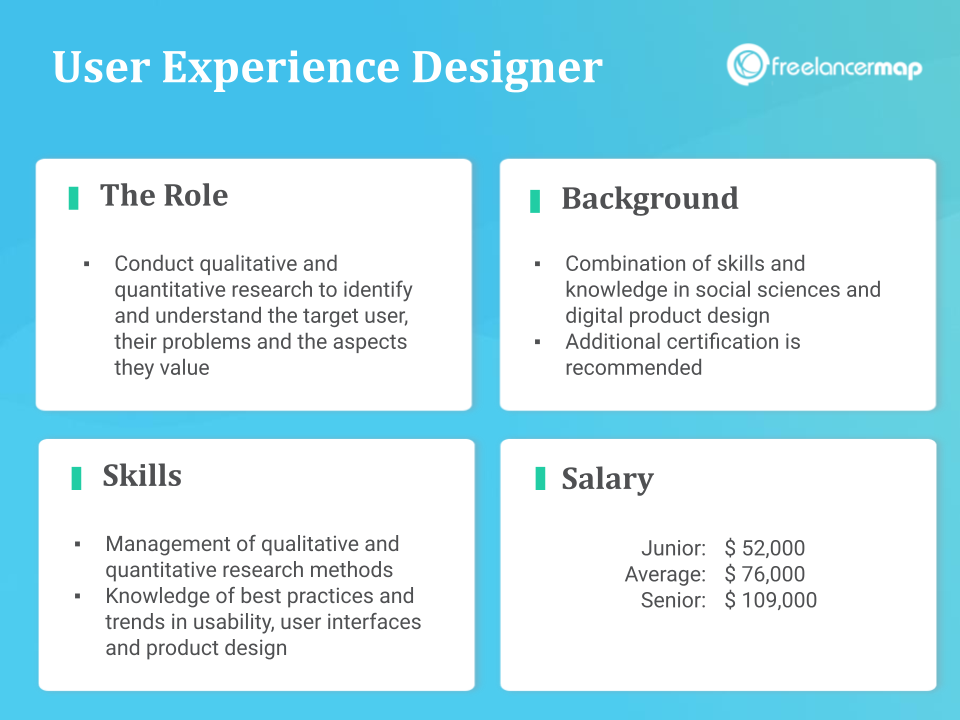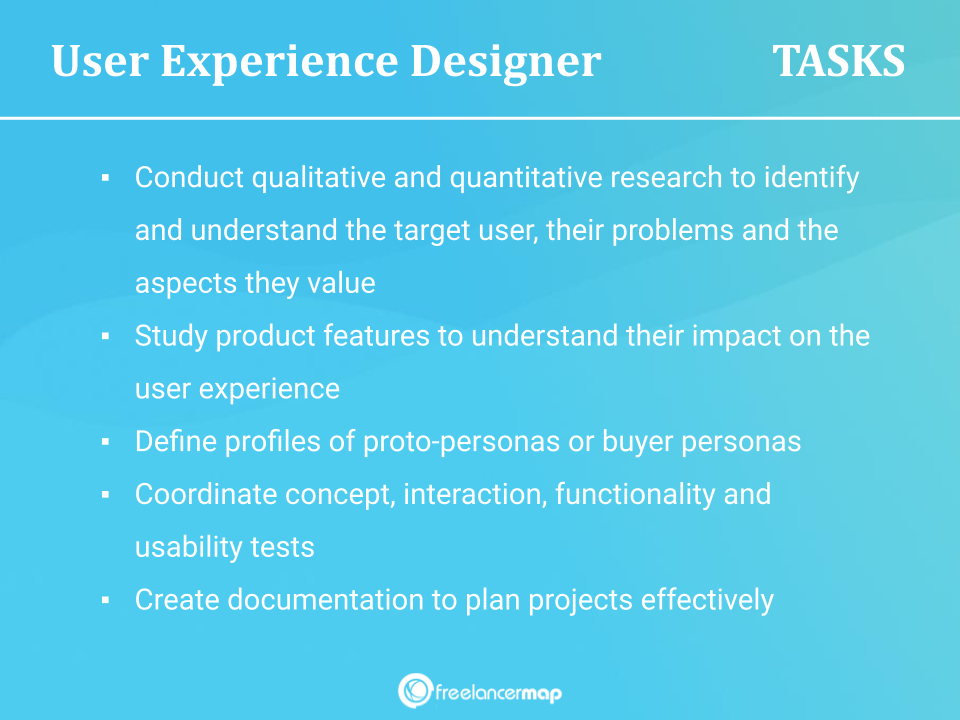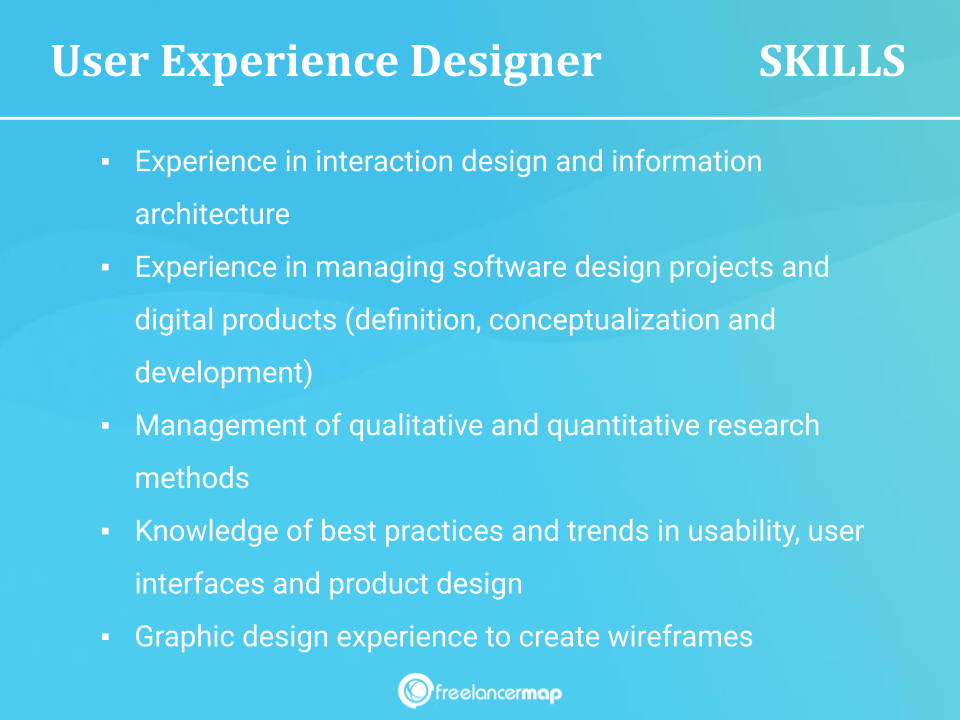A UX or user experience designer researches, analyzes and understands the needs of users to design solutions that add value to the customer, while being viable and profitable for the company. What does a user experience designer do?
Job Profile
Traditionally, the most prominent apps are those that offer creative solutions to users’ problems through an intuitive and user-friendly experience. This trend has practically become a law for UX design, a discipline that has surpassed the precepts of usability and ergonomics.
User experience design is the process in which the designer works to create amazing user experiences that makes it easier for users to do what they want. For this, it is necessary to carry out a preliminary investigation and design the entire product integration process.
While it is common to find the expression “UX/UI designer”, it is not correct to assume that a UX designer can cover the responsibilities of a UI designer or vice versa.
The acronym UI comes from the English expression User Interface, which means User Interface.


In summary, the difference between UX design and UI design starts with the difference in breadth and complexity between the UI and the experience a person experiences when using a software solution.
A user interface is described in specific technical terms and may cover specific features and functionality.
Instead, the UX experience encompasses:
- User interfaces, along with the context in which they are relevant
- Key functionalities in the hands of the software development team
- The relevance of certain processes and tasks
- The characteristics of the user experience in their interaction with others in their journey as a customer of the company
The importance of UX design
If you have ever used a mobile application, software or even a web page that has left you fascinated, it is very likely that a UX designer is responsible.
UX design places the user at the centre. For this reason, a designer deals with offering solutions to users’ problems in a creative and practical way.
Not only that, through a conscientious investigation (UX research), the UX designer is in charge of taking care of the user experience as a whole, from the appearance to the features and functionalities.
Here’re some UX statistics that show the importance of UX:
- ESPN.com revenues jumped 35% after they listened to their community and incorporated suggestions into their homepage redesign.
- 52% of users said a bad mobile experience made them less likely to engage with a company.
- 88% of online consumers are less likely to return to a site after a bad experience.
- Good UI can raise your website’s conversion rate by 200%.
- Better UX design can increase conversions by up to 400%.
Responsibilities
The UX designer is a role that has grown in popularity and complexity. Just a few years ago, a user experience designer could take on a complex and difficult-to-integrate set of tasks, ranging from market research to coordinating software testing.
Today, the role of the UX designer is more specialised. In the most ambitious projects or larger companies, you can find a user experience design team with specialised and complementary tasks that were initially taken on by a single expert.
Some profiles related to UX are:
- UX researcher: Focused on research, they conduct interviews, A/B tests, heat maps, usability, etc.
- UX writer: Works on the texts and copywriting of the product including buttons, links, menus, email marketing, etc.
- IxD designer: Responsible for the navigation flows and interactions with the different interfaces.
- UX designer: It is the profile that includes all of the above. Sometimes they will be in charge of carrying out all these tasks or if they have a team they will accompany them in the product design.


Regardless of the size of the team, the main role of the UX designer is to identify user problems, and come up with solutions and features to eliminate problems and provide a good user experience.
What are the responsibilities of a UX designer?
- Conduct qualitative and quantitative research to identify and understand the target user, their problems and the aspects they value
- Study product features to understand their impact on the user experience
- Define profiles of proto-personas or buyer personas
- Coordinate concept, interaction, functionality and usability tests
- Design prototypes, wireframes, and flowcharts, evaluation reports, and other deliverables
- Create documentation to plan projects effectively
- Work with the development team to communicate, co-create and test design ideas and concepts
- Perform usability testing and auditing
- Monitor industry trends and analyse competitors
- Work with UI designers to see how to implement the designs
In need of a UX designer?
> Find expert User Experience designers
Skills
UX designers need notions of psychology and neuromarketing (to understand the user), design (to identify what elements the product needs so that the user can use it) and also computer science and programming (to see what technical implication their ideas are going to have).
The most important skill for a UX designer is their ability to identify and communicate the most relevant aspects of the user experience.
They must be proficient with CSS, HTML, and JavaScript as well as with design software like UXPin.


Additionally, a UX designer must possess strong creative, empathetic and practical skills. They must also have excellent self-development skills and the ability to keep up to date with fast-changing trends.
What skills does a UX designer need?
- Experience in interaction design
- Experience in managing software design projects and digital products
- Management of qualitative and quantitative research methods
- Knowledge of best practices and trends in usability, user interfaces and product design
- Graphic design experience to create wireframes and prototypes
- Mastery of design and prototyping tools such as: Photoshop, Sketch, Illustrator, Adobe XD, InVision, etc.
- Strong design skills
- Knowledge to identify the needs of projects and their materialisation in Low-Fidelity or Hi-Fidelity wireframes
- Mastery of user experience mapping techniques
- Strong analytical skills and ability to solve complex problems
- Knowledge in marketing, communication, digital product development and human behaviour
- Basic HTML/CSS programming skills; Valuable JavaScript
Background
Do UX designers need a degree? There are currently no conventional academic training paths for a UX designer.
To start working as a UX designer, you need a combination of skills and knowledge in social sciences and digital product design, which are not yet part of the most recognized undergraduate university curricula.
However, continuing education and postgraduate programs in UX design are becoming more and more common.
There are ofcourse online courses you can refer to to boost your career and skills as a designer. Check out options for these down below:
- Human Computer Interaction For User Experience Designer
- Google UX Design Professional Certificate
- Learn User Experience Design from A-Z: Adobe XD UI/UX Design
- Complete Web & Mobile Designer in 2022: UI/UX, Figma, +more
- Master Digital Product Design: UX Research & UI Design
Salary
Depending on the specific responsibilities and the experience required for the position, the salary of a UX designer can vary considerably. The size of the company, the industry and the scope of the position also influence the salary of a UX designer.
Generally though, a designer who’s just starting out can expect a salary of around $52,000 whereas a more senior designer can earn around $109,000. The average salary of a designer is $76,000.
In the UK, the salary range of a user experience designer is £24,000-£50,000 whereas in Germany, the range is €31,000-€61,000.
What is the salary range of user experience designers?
| US | $52,000 – $109,000 |
| UK | £24,000 – £50,000 |
| Germany | €31,000 – €61,000 |
How much does a freelance user experience designer earn?
User Experience Designers on freelancermap charge on average:
Rates in this field range between $33 and $106/hour for most freelancers.
The daily rate for User Experience Designers (8 working hours) would be around:
Top 10 Tips to Become a Great UX Designer
User experience design is about producing the most optimal experience for the users of a website. But it’s not just about making a website aesthetically pleasing, it’s about having empathy for the users and making the site easy to use.
In a nutshell, user experience is about problem-solving and how the user feels when using a product or website. The secret to creating a great user experience is to not make the users think too much about what they are doing; this idea should come naturally to them.
So, what makes a great UX designer?
Here are some of the things Davina Spriggs, Freelance UX/UI Product designer, recommends taking into consideration when working as a UX professional:
1) Know your user
One of the most important skills you can have is knowing your user, this is where empathy is key. User-centered design is about how to design for your users’ goals. By finding out as much as possible about their needs, you’ll be designing a product that will give them the best user experience. Creating personas are a great way to begin to understand your users a little more. Grouping your basic user types based on what they intend to do on your site, provides you with useful insight around why your users will visit your site, and what their intentions are.
2) User research
User research is really the only true way to understand how your user thinks. By thoroughly researching our users, we can better understand their behavior and motivations. Without knowing this information, it can be difficult to design the best experience.
A good UX designer will always seek to understand how users are interacting and engaging with their product. One of the key elements here is to have the ability to ask questions and feedback from your users, listen to it and act on it. Usability testing is a simple process for this, even just sitting with a user and asking them to navigate through your website while they talk you through their thoughts can be highly effective in discovering potential problems, which leads to my next point…
3) Test your product
Usability testing is a fundamental component of any user experience project. It’s also one of the best ways to gain real insight into how your users will engage with your website or product. Ideas should be tested as early on in your project process as possible, this way you can develop features based on real evidence from users, instead of your own assumptions.
A/B testing (also known as split testing) is a reliable and common way to discover your user’s preferences. It’s also one of the most popular methods in helping to increase conversion rates. There are a number of online editors that make it easy for you to conduct these tests, this Mashable post has a good list.
Using web analytics tools is another way you can measure the statistics of live websites, Google analytics is most known for this. Remember, your website will only be as good as your user data tells you, and you can’t argue with that type of data.
4) Create a project process
By following a process, you will be able to manage your time and tasks more easily. My own simple workflow looks like this: Research, Design, Test, Implement.
As I’ve discussed above, user research is vital to your product and should be the starting point on any UX project. Design covers a number of elements including user-flow journeys, wire-framing, prototyping and final visual designs; all of these contribute to the user experience.
Testing is a process that should be carried out throughout the project timeframe, it’s much easier and quicker to discover and solve issues early on in the project for example before your website is built.
Finally, implementation, this is where your designs are brought to life, in my case this is by a team of developers who I work closely with to hand over the designs and ensure all of the site goals and functionality are met.
5) Find the right UX Tools
Knowledge is power, and practical UX experience alone won’t get you far unless you can find the right tools to work with. Build yourself a collection of resources that will help you create user-journeys, wireframes, prototypes and visual mock-ups.
My top tool of choice when getting started on a project is the good old-fashioned pencil and paper. Sketching out basic wireframes or user-journeys on a pad is, for me, one of the best ways to conceptualize initial designs.
Two more of my go-to tools are Photoshop and Illustrator, both are great for making basic wireframes or more elaborate visuals. Gliffy, Mockflow and UXPin are all good online resources for building wireframes and interface designs, and Marvel and Invisionapp are ideal for creating clickable prototypes of your design.
I recommend trying a few different tools and seeing what works for you, you’ll also find that different projects require different needs and I often switch between tools depending on what I need to achieve.
6) Be open-minded
As a UX designer you need to be able to work together with many different groups of people; from developers, project managers and other designers to major stake-holders of a company.
Often these groups of people can have conflicting ideas and opinions. You need to be able to successfully communicate your ideas and designs without becoming too attached to them. You can’t afford to become defensive about your work, remember you are designing for the user, not yourself and problems are often solved much easier when approached in a collaborative manner.
Good UX designers are great at problem-solving and overcoming challenges, and when user feedback or user data suggests possible problems with a website, you need to be able to adapt your designs accordingly.
7) Understand code
Understanding how a website is built has been highly valuable to me in my UX career. Not only does it help me create better websites, it helps me to interact more easily with developers. Having a basic grasp on HTML and CSS will help you understand how websites and online features are built.
UX designers will not typically get involved in programming or developing a website, however, knowing a little bit about the code behind it will help you to create more achievable designs.
All of your UX work will be built using code in the end, therefore a bit of knowledge about how the end product is built will always help you at the start of your project journey.
8) Create an online portfolio
Having your own website in WordPress and Squarespace have made this task very easy. When creating your online portfolio, don’t forget to show more than just your end designs, potential employers or freelance clients will often want to see evidence of how you arrived at your ideas.
Show your thinking behind your projects; include user journeys, wireframes and sketches along with the finished visual product. Explain the initial brief and how you came up with the solution.
If you came across obstacles in the journey, mention these too. UX projects will not always flow seamlessly from start to finish each time, showing that you are able to tackle setbacks will reveal your notable abilities as a UX professional.
9) Find a mentor
Having a mentor is one of the best ways to supplement your UX knowledge and training. Whether you’re a junior-level designer hoping to learn or just simply looking to expand on your UX education, look to other UX people for inspiration.
Reach out and spend time talking with other designers, show them what you’re working on, ask for feedback, and ask about their own projects. You could even turn to social networking by reaching out and connecting with other UX designers online, Twitter and Dribbble are good mediums for this. Dribbble in particular can be a good platform for asking for feedback and advice on your ongoing projects.
10) Become a self-learner
The exciting thing about UX design is that it is constantly evolving. There are always new trends to follow and new tools to discover and learn. Improving your own skills and knowledge is key for creative progression.
By keeping yourself up to date with the latest design technology and techniques, you’ll essentially be keeping yourself ahead of the game. There is a wealth of free online resources to help you do this. Take time out regularly to read through recent design news, blogs, tutorials or e-books. UX webinars are also another great source of information and ideas.
Being a UX designer is not just about producing visually attractive aesthetics, it’s about reacting to user’s problems and finding them the best solution. There are many steps you can make to become a great UX designer, and these tips by no means cover everything. However, the skills above are based on what I have learned and picked up throughout the years, and are essential in helping me produce and design effective and useful products.
